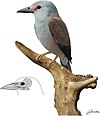Sapsucker
| Sapsuckers | |
|---|---|

| |
| Red-breasted sapsucker | |
| Scientific classification | |
| Domain: | Eukaryota |
| Kingdom: | Animalia |
| Phylum: | Chordata |
| Class: | Aves |
| Order: | Piciformes |
| Family: | Picidae |
| Tribe: | Melanerpini |
| Genus: | Sphyrapicus S.F. Baird, 1858 |
| Type species | |
| Pica varius[1] Linnaeus, 1766
| |
| Species | |
|
Sphyrapicus varius | |
The sapsuckers are species of North American woodpeckers in the genus Sphyrapicus.
Taxonomy and systematics
[edit]The genus Sphyrapicus was introduced in 1858 by the American naturalist Spencer Baird with the yellow-bellied sapsucker (Sphyrapicus varius) as the type species.[2] The genus name combines the Ancient Greek sphura meaning "hammer" and pikos meaning "woodpecker".[3] The genus is sister to the genus Melanerpes; both genera are members of the tribe Melanerpini in the woodpecker subfamily Picinae.[4]
There are four currently recognized species in the genus:[5]
| Common name | Scientific name and subspecies | Range | Size and ecology | IUCN status and estimated population |
|---|---|---|---|---|
| Red-naped sapsucker | Sphyrapicus nuchalis Baird, 1858 |
the Rocky Mountains and Great Basin areas of North America
|
Size: Habitat: Diet: |
LC
|
| Red-breasted sapsucker | Sphyrapicus ruber (Gmelin, JF, 1788) Two subspecies
|
southeast Alaska and British Columbia south through the Pacific Coast Ranges of western Washington and Oregon and northern California
|
Size: Habitat: Diet: |
LC
|
| Williamson's sapsucker | Sphyrapicus thyroideus (Cassin, 1852) |
western North America from northern Mexico as far north as British Columbia
|
Size: Habitat: Diet: |
LC
|
| Yellow-bellied sapsucker | Sphyrapicus varius (Linnaeus, 1766) |
Canada, eastern Alaska and the northeastern United States
|
Size: Habitat: Diet: |
LC
|
Description
[edit]The members of this genus are slender birds with stiff tails and relatively long wings. Their typical pattern in flight is undulating, alternating between quick bursts of wing beats and short dips with wings tucked against the body.[citation needed]
Behavior
[edit]
As their name implies, sapsuckers feed primarily on the sap of trees, moving among different tree and shrub species on a seasonal basis. Insects, especially those attracted to the sweet sap exuding from sap holes, are often captured and fed to the young during the breeding season. The most easily recognized sap holes are found in birch trees during the breeding season.[citation needed]
Because sapsuckers attack living trees, they are often considered a pest species.[6] Intensive feeding by sapsuckers is a cause of severe tree damage and mortality, with certain tree species more adversely affected by feeding than others. A USDA Forest Service study found that 67 percent of gray birch (Betula populifolia) trees damaged by yellow-bellied sapsuckers later died of their injuries.[7] This compares to a mortality of 51 percent for paper birch (Betula papyrifera), 40 percent for red maple (Acer rubrum), 3 percent for red spruce (Picea rubens), and 1 percent for hemlock (Tsuga canadensis).[7]
References
[edit]- ^ "Picidae". aviansystematics.org. The Trust for Avian Systematics. Retrieved 2023-07-26.
- ^ Baird, Spencer F. (1858). Reports of explorations and surveys to ascertain the most practical and economical route for a railroad from the Mississippi River to the Pacific Ocean made under the direction of the secretary of war in 1853-1856. Vol. 9 Birds. Washington: Beverly Tucker, printer. pp. xviii, xxviii, 80, 101.
- ^ Jobling, James A. (2010). Helm Dictionary of Scientific Bird Names. London, UK: Christopher Helm. p. 362. ISBN 978-1-4081-2501-4.
- ^ Shakya, S.B.; Fuchs, J.; Pons, J.-M.; Sheldon, F.H. (2017). "Tapping the woodpecker tree for evolutionary insight". Molecular Phylogenetics and Evolution. 116: 182–191. doi:10.1016/j.ympev.2017.09.005. PMID 28890006.
- ^ "ITIS Report: Sphyrapicus". Integrated Taxonomic Information System. Retrieved 3 May 2013.
- ^ Tate, J. (1973). "Methods and annual sequence of foraging by the sapsucker". Auk. 90 (4): 840–856. doi:10.2307/4084364. JSTOR 4084364.
- ^ a b Rushmore, Francis (1969). Sapsucker: Damage Varies with Tree Species and Seasons (PDF) (Thesis). Vol. Forest Service Research Paper NE-136. Northeastern Forest Experiment Station, Upper Darby, PA: USDA.













